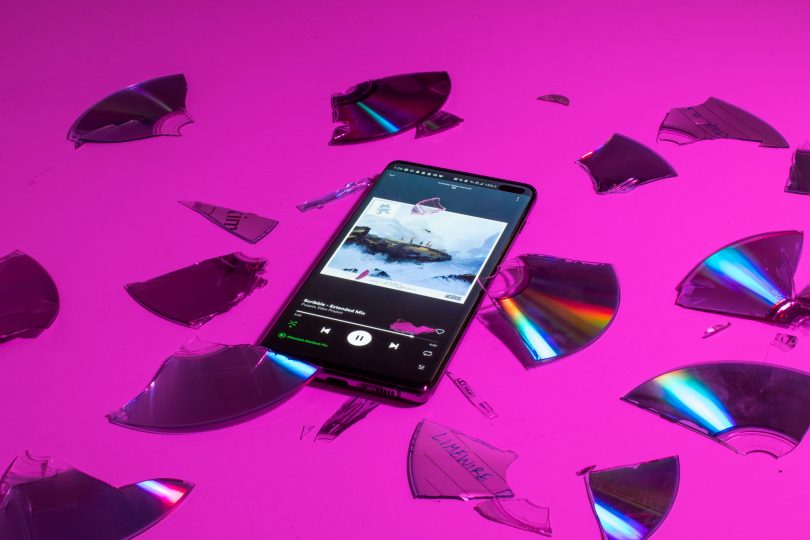🎧 Listen to an abridged audio version of this story above.
In 1982 the CD was introduced. It was meant to replace the vinyl format as the new way to consume music, and for a long time it did that. Vinyl pressing plants closed, and vinyl became a niche product, delegated to second-hand record stores and op shops.
But as digital music and streaming have become more and more popular, vinyl has made a significant comeback.
The latest data from ARIA (released in 2020) clearly shows streaming music is more profitable than any physical medium, and it has been that way since 2016, when streaming passed CDs for the first time.
CD sales have continued to drop, but vinyl has risen, and is expected to pass CDs in terms of profitability this year.
It’s not just in Australia either, as all around the world vinyl is having a comeback.
In the US, CD revenue dropped by 23.4% between 2019-2020, while vinyl revenue increased by 29.2%.[1]
In the UK, CD and vinyl revenue saw similar results, with CDs dropping 18.5% as vinyl grew by 30.5%.[2]
In Australia, CD album sales dropped 17.2% between 2019-2020, and vinyl albums grew 32%.[3]
But even as vinyl is expected to overtake the CD in 2021, streaming remains the most profitable worldwide, with no signs of stopping. This is true for both majors and independent record labels, though in the UK independent artists still make up a significant percentage of revenue from physical media.
Other formats
While CDs were intended to replace vinyl, it was thought they too would be replaced eventually by other physical formats. These were the Minidisc (1992), HDCD (1995), SACD (1999), and DVD Audio (2000).
To be fair, Minidiscs were more of an alternative than a replacement, but HDCD, SACD, and DVD Audio were all pushed as the next big thing at one point thanks to their greater audio quality and the ability to produce sound in 5.1 surround.
CD stores in Australia each had small sections of these superior formats, but none ever took off in a major way.
Worldwide, the popularity of each format can be tracked by how many items have been added to Discogs’ database. This looks at individual releases, and not the number of items produced or sold. It also relies on user generated data so isn’t 100% accurate, but it still gives a good illustration of the formats people were buying, and have collected over the years.
According to Discogs, the number of CDs produced has never gone under 50,000 since 1990, while none of those other formats ever cracked 2,000.
Oddly, while most of these formats have gone away, the number of Minidiscs produced has increased. Enough so that in 2012 the UK’s Official Chart Company reported on the curiosity.
Cassette tapes also made their own comeback, and the number of cassettes produced in 2020 was 26,670. It’s not a lot compared to 55,883 CDs or 92,422 vinyl from 2020, but at least it’s more than the 264 Minidisc which were produced, according to Discogs.
Another take away from the data on Discogs is that CDs have already lost their dominance. With the number of CDs added to their database falling while vinyl rose over the past decade.
What do musicians think of CDs now?
Earlier this year, when Lorde revealed her latest album Solar Power, she announced there would be no CD edition. Instead a CD sized Music Box edition was released with booklet, art cards, poster, and a download code to listen to the album.
Naturally there were still (eight!) vinyl editions, but she explained, “I think vinyl is still something people keep for a long time. Whereas I think even the CD enthusiasts among us would agree that it feels like less of a permanent product.”
CD enthusiasts would perhaps disagree with that assessment, but luckily there are still musicians and labels releasing music on CD in 2021.
One of those is Room40, an Australian label which is recognised worldwide for their experimental music releases. In October they put out Polar Force, a new CD by Philip Samartzis, a Melbourne based sound artists and RMIT lecturer.
When I spoke with Philip recently, he told me he remains a fan of CDs.
“I still buy them, and there are certain things about CDs, and LPs of course, that streaming services don't provide. A lot of the contextual information that explains what we're hearing, the liner notes, the credits, the acknowledgments, all that kind of stuff I’m unable to find on Spotify.”
Polar Force was released on CD with a book of essays and photography, and comes with a digital download too.
“So it is analogue and digital in that sense”, Philip said. “And for all intents and purposes, most people are likely to encounter the work through the digital download option. But you do get the benefit of the of the object in this instance.”
Another Australian label putting out experimental music is Nice Music, run by Simon J. Karis in Melbourne. They have yet to release any CDs, but Simon revealed that will change soon.
“We’re putting out our first CD release later this year. I think it suits the music and I really love electronic music on CD specifically”, he said.
Nice Music started out releasing cassettes before moving to vinyl, and one of the appeals of a CD release now is because of how they have become an underdog as streaming and vinyl gain popularity.
“I like CDs, but there is something very strange about the format. It's very out of place”, Simon said.
“After being a bit out of fashion it's very in vogue to release shiny objects now, so I think there's a bit more of an audience for it as a weird object rather than a practical object.”
Philip agrees, telling me each technology holds importance to their specific audience or generation, and so will likely come back.
“CDs might not be as popular as LPs right this moment, and then in five years’ time all of a sudden they happen again, like how people buy tapes. As long as there’s technology to play it, I think there will be an audience for years.”
So although CD sales are dropping, they could very well level out and stay with us, much like vinyl and cassettes did during the 1990s and 2000s.
In the meantime though, the CD find itself in a weird position.
Sound quality wise, CDs are cleaner than vinyl and can hold more music per disc.
For artwork, the CD is 5” compared to a vinyl albums 12” so vinyl wins there. But for an easy to hold item, especially for fans of reading liner notes and album booklets, CDs are far more convenient.
On price, streaming naturally wins out. Unless you want to own your music, in which case a CD might cost around the same as a digital download, depending on where its bought.
Finally there’s availability. Notwithstanding licensing issues, where albums disappear from streaming services thanks to contract negotiations, there is generally more music available online now then there has ever been at your local record store.
And on that point I’ll leave it to Philip Samartzis to sum up.
“It's like having a library at your fingertips. It's a complete history of music in your in your hip pocket. You can't really criticize that. Can you?”
Sources
[1] https://www.riaa.com/wp-content/uploads/2021/02/2020-Year-End-Music-Industry-Revenue-Report.pdf
[2] https://www.bpi.co.uk/news-analysis/uk-recorded-music-revenues-grew-38-in-2020/
[3] https://www.dropbox.com/sh/d97w2gurvkd6h84/AAC2wdyJ9SlkQ28KYEDZk1XOa?dl=0&lst=&preview=ARIAYearlyStatistics2020.pdf
Featured Image by Nicholas Nguyen on Unsplash




I still buy cds they are much better than vynyl which are bulky delicate expensive wear out when you play them and crackle and pop when played cds are small dont wear out you can copy them to memory stick to listen in the car they are cheap to buy as well